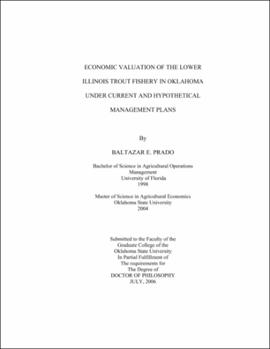| dc.contributor.advisor | Boyer, Tracy | |
| dc.contributor.author | Prado, Baltazar E. | |
| dc.date.accessioned | 2013-11-26T08:22:04Z | |
| dc.date.available | 2013-11-26T08:22:04Z | |
| dc.date.issued | 2006-07 | |
| dc.identifier.uri | https://hdl.handle.net/11244/6535 | |
| dc.description.abstract | Scope and Method of Study: A valuation study of the Lower Illinois River trout fishery in northeastern Oklahoma estimated users' demand for trout angling, visitation rates, and economic efficiency of maintaining the resource. During 2004, an on-site creel survey and a discrete choice survey were conducted to estimate visitation rates and preferences for different management changes in the fishery. A follow-up interview was given by telephone to gather travel cost and demographic information. A travel cost model was used to measure demand for angling using a negative binomial count model. Results from the on-site and telephone survey were statistically tested for recall bias. The total visitation rate was estimated using a traditional angler and car count method and a poison count model. A simple cost-benefit framework to test feasibility of the project and management changes was conducted. | |
| dc.description.abstract | Findings and Conclusions: The calculated average consumer surplus per angler per recreation day is estimated at 112.54 with a 90% confidence interval between (79.19, 194.38). For those who went for multiple recreation activities, the average consumer surplus per person per recreation day is 31.66. The total consumer surplus generated from the LIR trout fishery, assuming all visitors are single purpose visitors (anglers only), is 2,069,723/year (using annual 18,391 annual visits). The total benefits of keeping the trout fishery in operation exceeds the total costs to manage it in all of the tested scenarios in both the financial and social cost benefit analysis. A comparison of travel costs obtained by the on site reported travel costs and the phone interview travel cost responses (a month later) showed the mean difference in travel costs was 50.36 and was attributed to incomplete trips on site and potential recall bias. The discrete choice experiment indicated that anglers are willing to pay for an increase in the size of the stocked trout in the amount of 9.22/ year and 3.41/ year for an increase of 20% in the number of rainbow trout stocked. The creation of catch and release areas is not preferred. | |
| dc.format | application/pdf | |
| dc.language | en_US | |
| dc.rights | Copyright is held by the author who has granted the Oklahoma State University Library the non-exclusive right to share this material in its institutional repository. Contact Digital Library Services at lib-dls@okstate.edu or 405-744-9161 for the permission policy on the use, reproduction or distribution of this material. | |
| dc.title | Economic valuation of the Lower Illinois trout fishery in Oklahoma under current and hypothetical management plans | |
| dc.contributor.committeeMember | Stoecker, Arthur | |
| dc.contributor.committeeMember | Chung, Chanjin | |
| dc.contributor.committeeMember | Norwood, Bailey | |
| dc.contributor.committeeMember | Fisher, Bill | |
| osu.filename | Prado_okstate_0664D_1972.pdf | |
| osu.accesstype | Open Access | |
| dc.type.genre | Dissertation | |
| dc.type.material | Text | |
| thesis.degree.discipline | Agricultural Economics | |
| thesis.degree.grantor | Oklahoma State University | |
